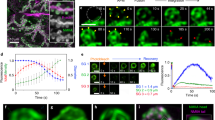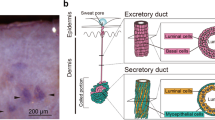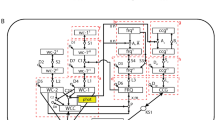Abstract
Cellular mechanisms of secretion in exocrine and endocrine glands are technically difficult to study. We present here a model which offers fundamental advantages for studying excitation–secretion coupling at the level of the isolated single cell. The salivary gland of the leech Haementeria ghilianii possesses a unique combination of unusual properties which greatly facilitate research in this area. Its cells are exceptionally large (up to 1 mm in diameter), clearly visible and easy to penetrate with microelectrodes. They do not form a homogeneous population but consist of five distinct histochemical types, secreting a number of identified products such as the fibrinolytic enzyme hementin (for which there is a sensitive assay). The cells generate overshooting calcium-dependent action potentials up to 90 mV in amplitude and with a duration of 200–1,000 ms. One of their most useful and unusual features is a lack of electrical coupling which means that individual cells can be studied in an intact gland without interference from neighbouring cells.
This is a preview of subscription content, access via your institution
Access options
Subscribe to this journal
Receive 51 print issues and online access
$199.00 per year
only $3.90 per issue
Buy this article
- Purchase on Springer Link
- Instant access to full article PDF
Prices may be subject to local taxes which are calculated during checkout
Similar content being viewed by others
References
Sawyer, R. T. Yb. Am. phil Soc., 212–213 (1978).
Damas, D. Archs Zool. exp. gén. 115, 279–292 (1974).
Sawyer, R. T., Damas, D. & Tomic, M. Archs Zool. exp gén. 122, 411–425 (1982).
Sawyer, R. T. Leech Biology and Behaviour (Oxford University Press, 1985).
Budzynski, A. Z., Olexa, S. A., Brizuela, B. S., Sawyer, R. T. & Stent, G. S. Proc. Soc. exp. Biol Med. 168, 266–275 (1981).
Budzynski, A. Z., Olexa, S. A. & Sawyer, R. T. Proc. Soc. exp. Biol. Med. 168, 259–265 (1981).
Marshall, C. G. & Lent, C. M. J. exp. Biol. 113, 367–380 (1985).
Muller, K. J., Nicholls, J. G. & Stent, G. S. (eds) Neurobiology of the Leech (Cold Spring Harbor Laboratory, New York, 1981).
Kater, S. B. Soc. Neurosci. Symp. 2, 195–214 (1977).
Peterson, O. H. The Electrophysiology of Gland Cells (Academic, London, 1980).
Gerschenfeld, H. M., Hamon, M. & Paupardin-Tritsch, D. J. Physiol., Lond. 274, 265–278 (1978).
Matthews, E. K. & Sakamoto, Y. J. Physiol., Lond. 246, 421–437 (1975).
Kidokoro, Y. Nature 258, 741–742 (1975).
Brandt, B. L., Hagiwara, S., Kidokoro, Y. & Miyazaki, S. J. Physiol., Lond. 263, 417–439 (1976).
Kater, S. B., Rued, J. R. & Murphy, A. D. J. exp. Biol. 72, 77–90 (1978).
Author information
Authors and Affiliations
Rights and permissions
About this article
Cite this article
Jones, P., Sawyer, R. & Berry, M. Novel preparation for studying excitation–secretion coupling in the isolated single cell. Nature 315, 679–680 (1985). https://doi.org/10.1038/315679a0
Received:
Accepted:
Issue Date:
DOI: https://doi.org/10.1038/315679a0
This article is cited by
-
Secretion of hementin and other antihaemostatic factors in the salivary gland complex of the giant amazon leech Haementeria ghilianii
Comparative Haematology International (1991)
-
Electrophysiology leech giant salivary cells
Nature (1985)
Comments
By submitting a comment you agree to abide by our Terms and Community Guidelines. If you find something abusive or that does not comply with our terms or guidelines please flag it as inappropriate.



